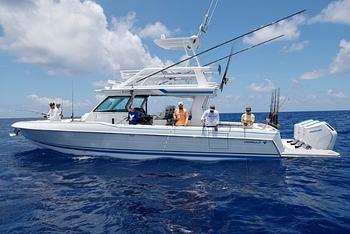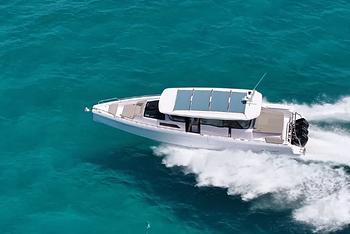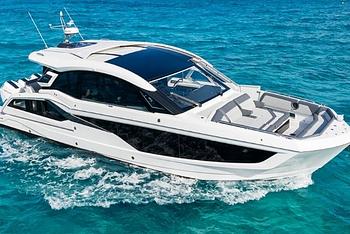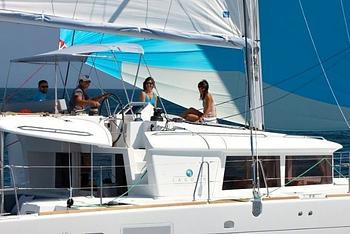I had the pleasure of sailing the new Lagoon 40 at the Miami Boat Show in 2018 where hopes were high that the French builder had finally tapped into the magic formula to successfully replace their long-ruling golden child, the Lagoon 380.
From the drawing board of premier designers VPLP and Patrick Le Quement, the Lagoon 40 actually replaced the Lagoon 39, which had been put forth as the successor to the L380. But with roughly the same sail area as the L380, the L39 was heavier and never enjoyed the same success. In a fresh attempt to create a new entry-level catamaran model, the builder focused on keeping weight in check while signaling a different design approach by giving the Lagoon 40 a more angular aesthetic with squared transoms, longer rectangular hull ports, and a coachroof that flowed into an up-angled composite Bimini.
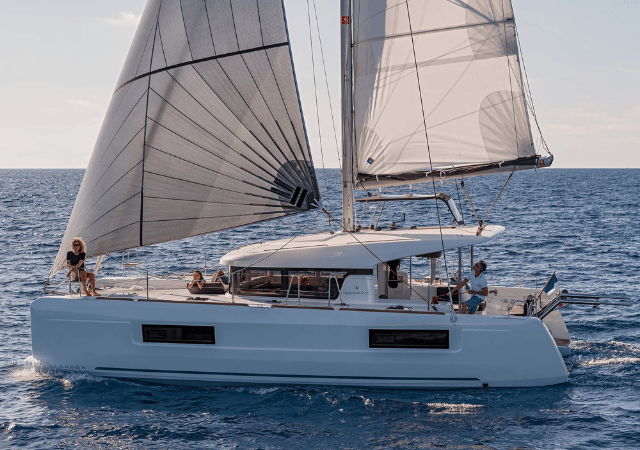
Lagoon 40 under sail. Photo credit: Lagoon
Lagoon 40 Key Features Fore and Aft
Both at the forward and aft ends of the platform, the Lagoon 40 differed from her predecessors on deck. Starting forward, a sun pad with lifting headrests was added and together with the trampoline this really increased lounge space. The sunbed cushions are atop two mammoth lockers that hide the windlass and the water tank. For convenience, two small opening ports were integrated into the forward window facilitating passing drinks and snacks from the galley and saving a trip through the cockpit. A ladder rests on the coachroof and flips down for fast access from the foredeck to the mast. It’s a simple solution although not easy to use with wet feet or when the boat is bouncing since there’s little to hold onto.
Continuing aft on the starboard side, we come to the helm at deck level. This elevated placement has a few benefits: it’s easy for the skipper to step out onto the side deck to quickly lend a hand with dock lines, and the wheel is partially protected from the elements by the forward bulkhead and the hardtop above. One set of stairs leads from the helm onto the Bimini so crew can manage the sail in the bag, and another set leads from the helm to the cockpit so the skipper can dash down four steps to ask for help or grab a sandwich.
Visibility from the wheel has its challenges. It’s good looking aft to the transoms when you duck under the Bimini, but it’s limited forward especially for shorter skippers who may struggle to see both bows. Lagoon must have anticipated this because they provided an integrated step that folds down from the bulkhead to add height. However, from there, it’s hard to reach the engine throttles so when docking, it’s a tradeoff between good sightlines to the bows and confident control of the motors. That’s not a tradeoff most skippers are comfortable with.
All the way aft, the changes from earlier models included square transoms with two low steps that lead up from the swim platforms to the cockpit. The level changes were purposely kept moderate and look less cumbersome than before. Although compact, the cockpit enjoys a standard catamaran layout that will be comfortable for 7-8. The dinette is to port with seating for six, a lounge is across to starboard, and a short transom seat was added for extra capacity. The resulting traffic flows freely past the table and on to the helm, transoms, or side decks.
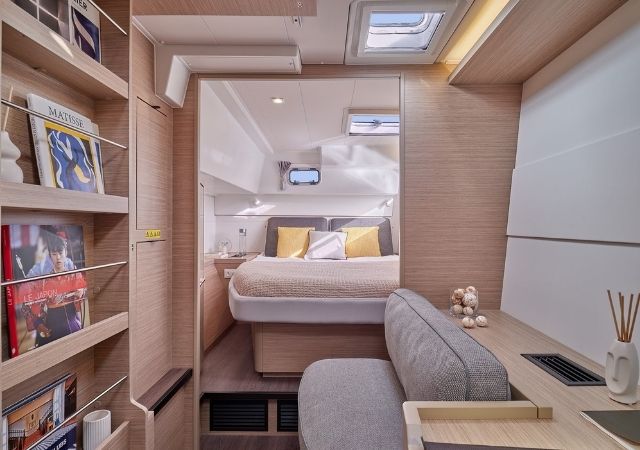
Lagoon 40 master cabin. Photo credit: Lagoon
Lagoon 40 Accommodations
Interior changes weren’t dramatic, but a few tweaks were added for a touch of upgraded luxury. The stark white fiberglass surfaces and bland cabinetry are gone, replaced with darker shades of brown wood veneer and leather accents that add a luxe feel.
The Lagoon 40 is available with 3-4 cabins and 2-4 heads. The owner’s version includes a master suite that sprawls across the entire port hull, and this would be my choice of layout for comfortable cruising. The head is forward with a large shower stall and the berth is aft with a cut-away bed on one side for easier access. In the middle is a small vanity desk and settee. I’m never sure if these mid-section features are welcome or just places to toss clothes and therefore become a terrible waste of space but it no doubt depends on the individual. A sliding door encloses the whole stateroom enhancing privacy and as a bonus, it has a built-in bookcase. Both ends of the cabin enjoy ample natural light from overhead hatches and long hull windows.
To starboard are two guest cabins that share a Jack-and-Jill head with a large common shower stall in the middle. There are two charter layouts available: one with four cabins and two heads as just described, and another with four cabins and four heads. Four heads in just 40 feet proved to be too choppy and completely unnecessary, and it’s unlikely you’ll find many of these layouts on the pre-owned market.
The saloon arrangement on the main deck remained familiar when introduced. The galley is in the aft port corner with a three-burner stove, an under-counter front-loading refrigerator, and decent stowage. The saloon settee and an additional Isotherm refrigerator/freezer and overhead lockers for provisions are to starboard. A nav desk is forward of the galley in the port corner and has room for an MFD and other navigational instruments. It’s small but critical for keeping necessities like guides, pens, flashlights, and the other detritus of cruising. Everything here on the main deck is compact, but Lagoon did a fair job of shoehorning in every needed feature. For a couple with occasional guests or kids, it works well.
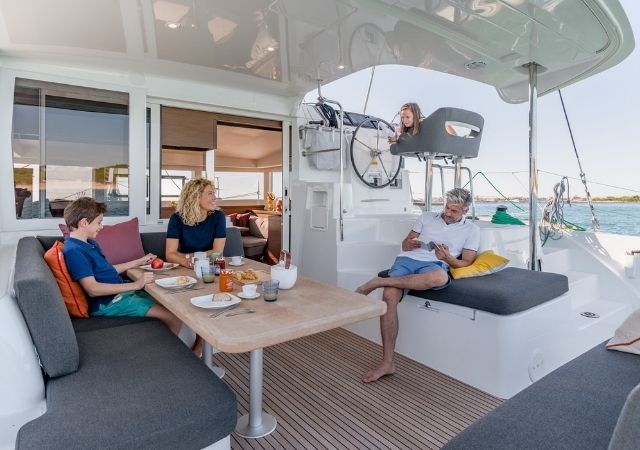
Lagoon aft cockpit. Photo credit: Lagoon
Lagoon 40 Performance
The 60’ 5” mast makes the Lagoon 40 well-suited for cruising the ICW but she’ll also be agile offshore on the “outside” in the trades. In 16-18 knots of wind, our test sail off Miami Beach was a jolly good time. We just kissed 10 knots on a beam reach and even at 50 degrees apparent wind angle, we cruised at 7.5-8 knots. Pinching any higher, the boat began to stall but that’s not unusual for a cruising catamaran with fixed keels. The two keys to performance on this model are the square-top mainsail and the 706-square foot Code 0. Combine these with the self-tacking jib and you have a versatile sail plan that’s easily managed shorthanded.
Standard propulsion for the Lagoon 40 was twin 29-hp Yanmar diesels with Saildrives. A worthy upgrade was 45-hp engines, which is something to look for when purchasing this model today. With the larger motors, our test boat cruised at 7.5 knots at 2400 rpm, which is right in the ballpark for this class. The engine room hatches were made to open aft rather than out to the side for safety so the skipper wouldn’t be at risk of falling down the swim steps and overboard if doing an inspection under way.
Lagoon 40 Pros & Cons
In a world of ever bigger boats, it’s nice to find a platform that delivers everything a couple needs but doesn’t overwhelm in terms of necessary budget or slip size. This model is agile enough to head home in a hurry but also has an easy-to-manage sail plan that one or two people won’t find intimidating. Wood trim and more upmarket finishes and fabrics set this design apart and life aboard doesn’t feel like camping in an expanse of white surfaces.
On the flip side of enjoying a compact cat is our tendency to live large today. Houses, cars, and boats have all grown bigger so although perfect for some, the Lagoon 40 can feel a bit pint-sized for others. The standard water tankage was light but that’s fixable with a water maker. Also, the helm may be challenging for short sailors as described above.
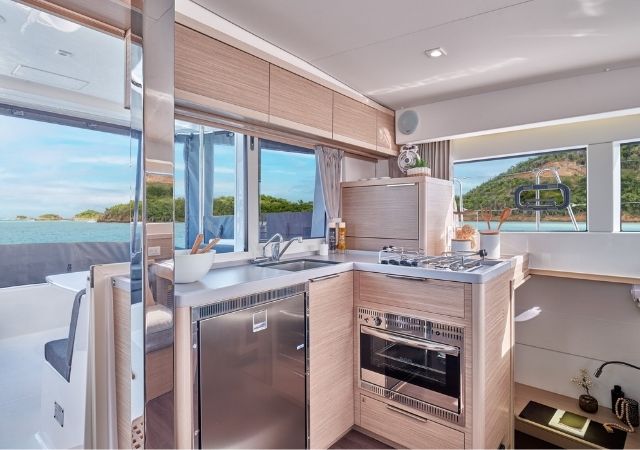
Lagoon 40 galley. Photo credit: Lagoon
Why Buy a Lagoon 40 Used?
The base price of the Lagoon 40 in 2018 was just over $320,000 and well-equipped, it went for another $100,000 more at least. The design has kept its value well, which speaks to the strength of Lagoon’s brand and to the model’s appeal. It’ll work well for boaters looking to hold this investment for a few years. When shopping, look for boats with the upgraded engines and a good inventory of lightly used sails including the square-top main and Code 0. Unless the boat will be used for charter, the three-cabin owner’s version will be preferable.
Conclusion
The Lagoon 380 proved hard to trounce and eventually its sheer sales volume was topped only by the Lagoon 42. However, the Lagoon 40 found significant success as well with just over 400 hulls built. Today, this model still represents a well-proportioned couple’s boat with lively performance and enough comfort for distance cruising.
See all Lagoon 40s for sale on Rightboat.
To learn more about a variety of top catamaran brands, read Best Catamaran Brands: Exploring the Multihull World.
Lagoon 40 Technical Specifications
Designer: Van Peteghem Lauriot Prevost (VPLP)
LOA: 41' 10"
Beam: 22' 2"
Draft: 4’5"
Sail Area: 875 sq. ft.
Displacement (light): 24,001 lbs.
Water: 79 gal.
Fuel: 106 gal.
Air draft: 60’ 5”
Engines: Twin 29-hp Yanmar diesels

